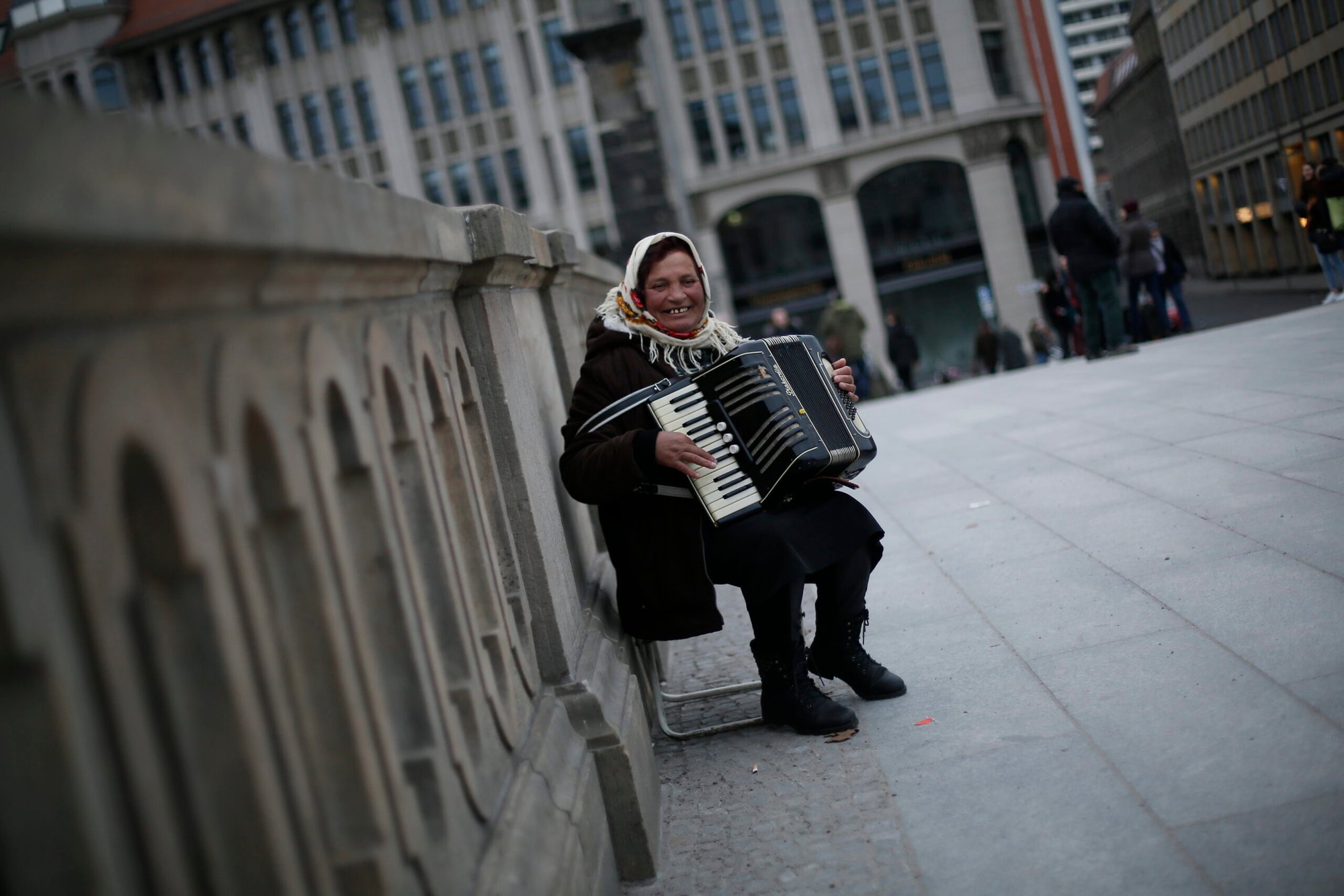
© Ulaş Yunus Tosun
Germany, Berlin, February 26, 2017.
A woman weaves melodies through the streets of Berlin with her accordion.
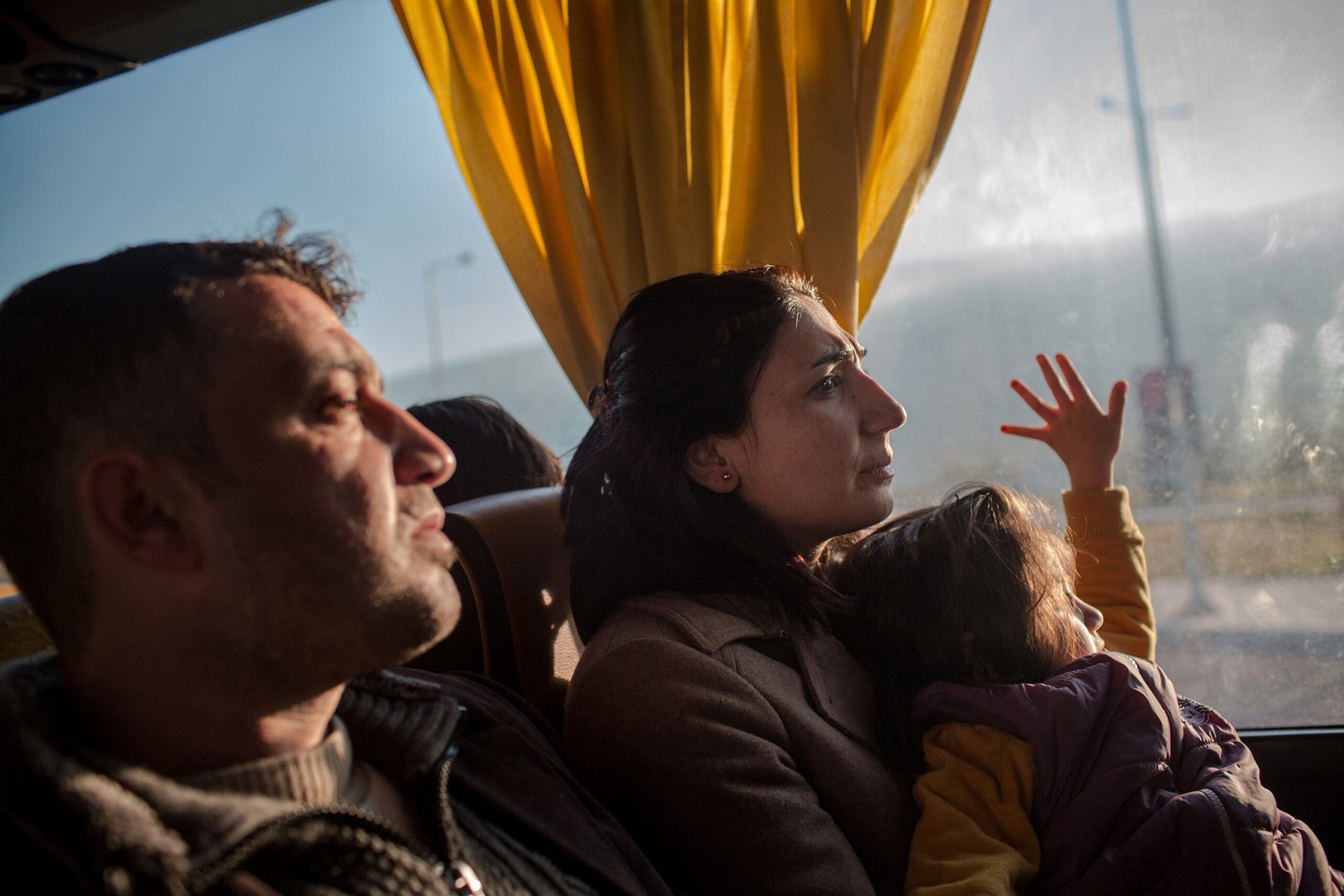
© Nicole Tung
December 19, 2015.
Tariq, left, Nisreen, and their five-year-old daughter Roslyn, are seen on the day-long bus ride from Athens to the Greek-Macedonian border in the far north, as they continue their journey from Syria to Germany. Over one million refugees and migrants have reached Europe’s shores this year, overwhelming the continent and presenting the worst refugee crisis since World War II. Many thousands have been fleeing from conflict in Syria, Iraq, and Afghanistan; while thousands of others, from Bangladesh, Iran, and Pakistan, seek better livelihoods. The recent three-billion euro deal struck between Turkey and the EU, intended to reduce the flow of people to Europe, has resulted in Turkish authorities cracking down on smugglers and rounding up refugees; preventing them from making the sea crossing, but some continue to persist.
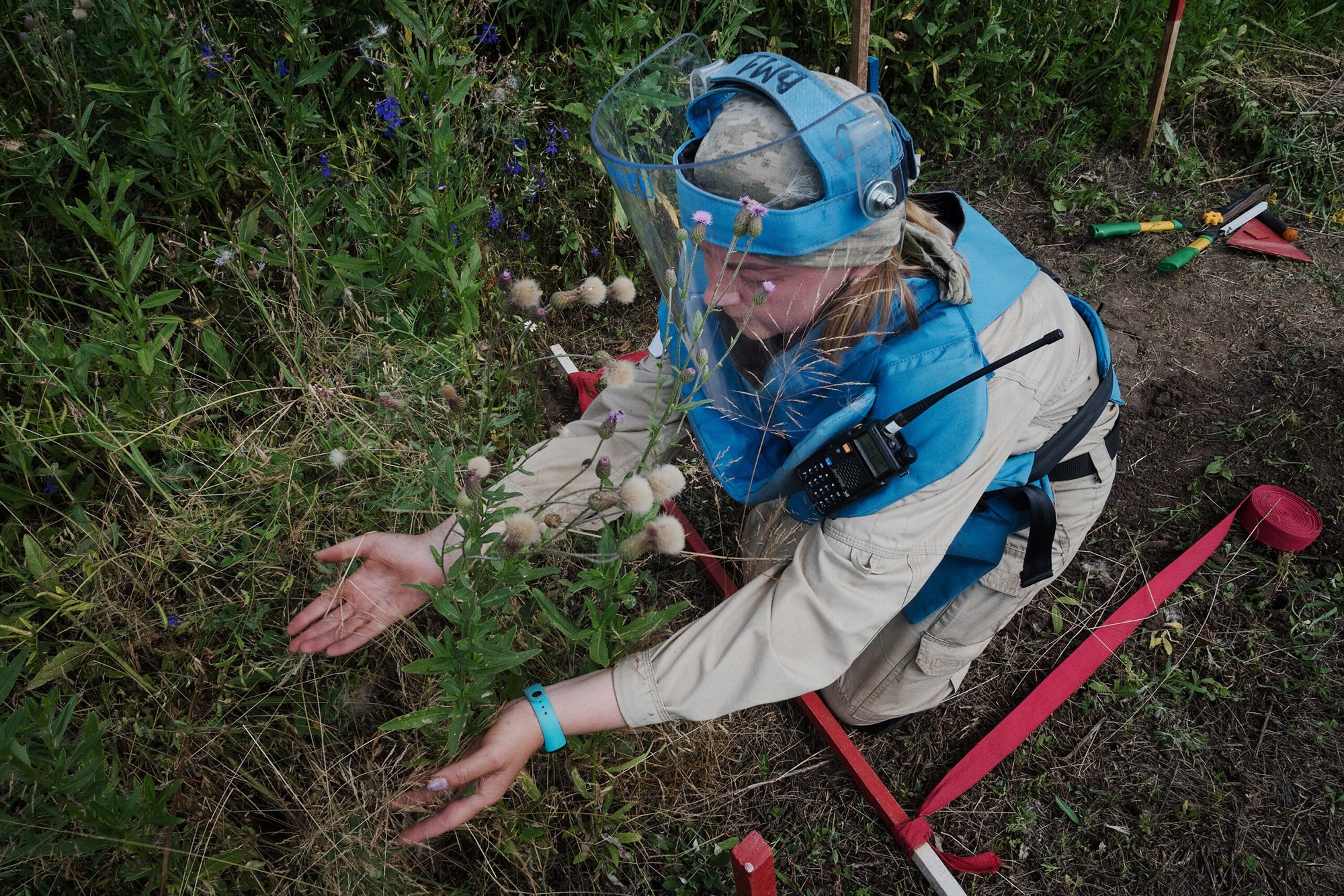
© Gaelle Girbes
Ukraine, Donbas, July 9, 2021.
Lioubov, a deminer at the Danish Demining Group (DDG), gently combs the tall grass between her fingers to check that there are no wires triggering a potential explosive device. Improvised explosive devices are a common sight in Donbas.
After ten years of conflict, Ukraine is now one of the most heavily mined countries in the world. The soil of Donbas is polluted by numerous landmines and unexploded shells—homemade explosive traps are scattered everywhere.
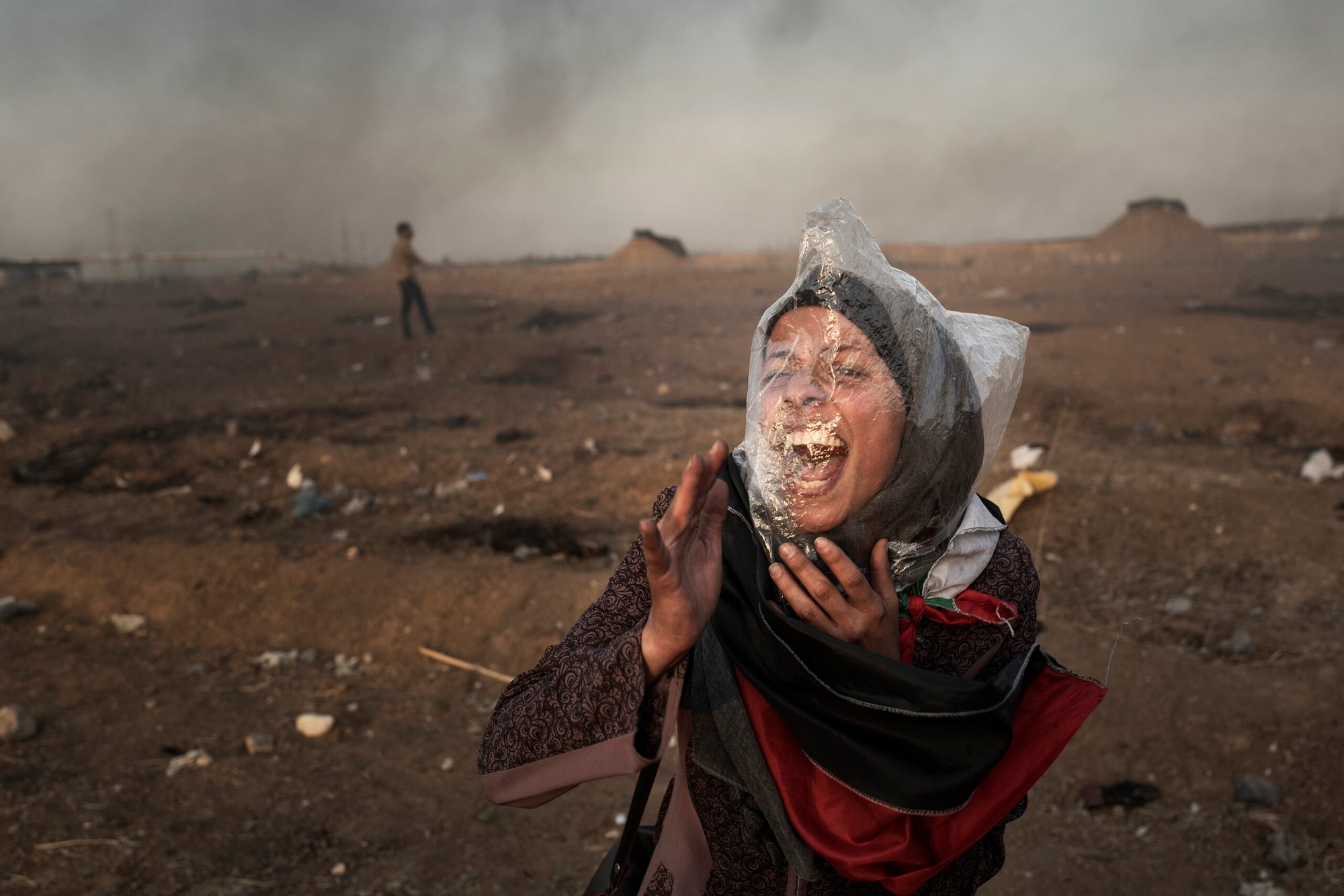
© Fabio Bucciarelli
Palestine, Gaza, May 18, 2018
A Palestinian woman screams during a protest against the Israeli siege of the Gaza Strip at the border of Eastern Gaza City. Demonstrators use plastic bags to cover their faces, protecting themselves against tear gas launched by Israel Defense Forces (IDF) soldiers.
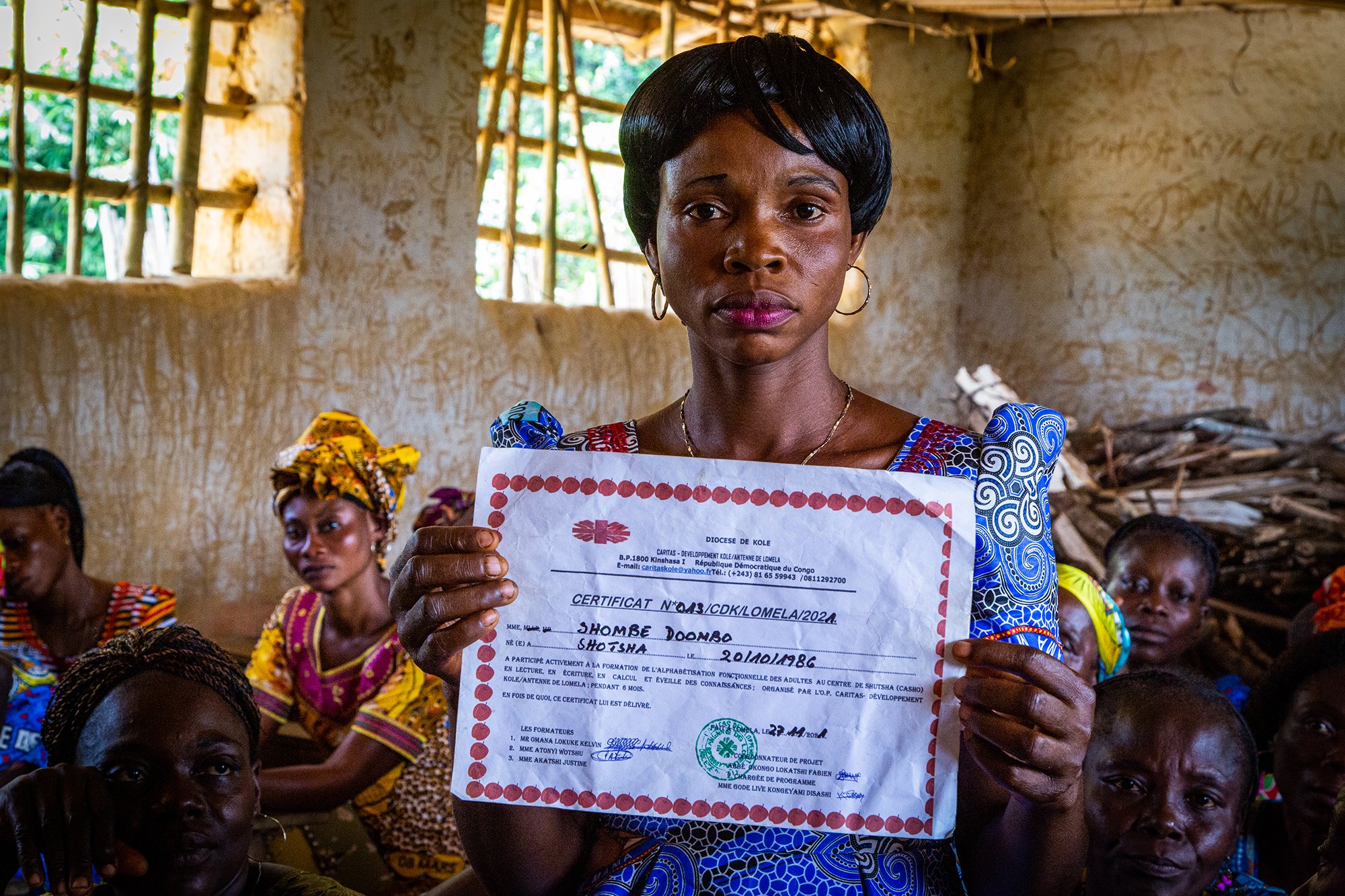
© Justin Makangara
Democratic Republic of the Congo, Sankuru province, Lokolo village, March 8, 2023.
Shombe Dombo Carine, 35, is the mother of eight children. She is presenting her certificate during the celebration of International Women’s Day, in Lokolo in the province of Sankuru. Having now learned to read and write, she would like to be able to use her new skills to fight for her rights as a woman. “As a child, I never went to school, and then I had to stay at home as a woman. It was out of curiosity that I enrolled in the literacy training program. Now that I know how to read, write, count and calculate, I understand the value of having taken part in this course.”
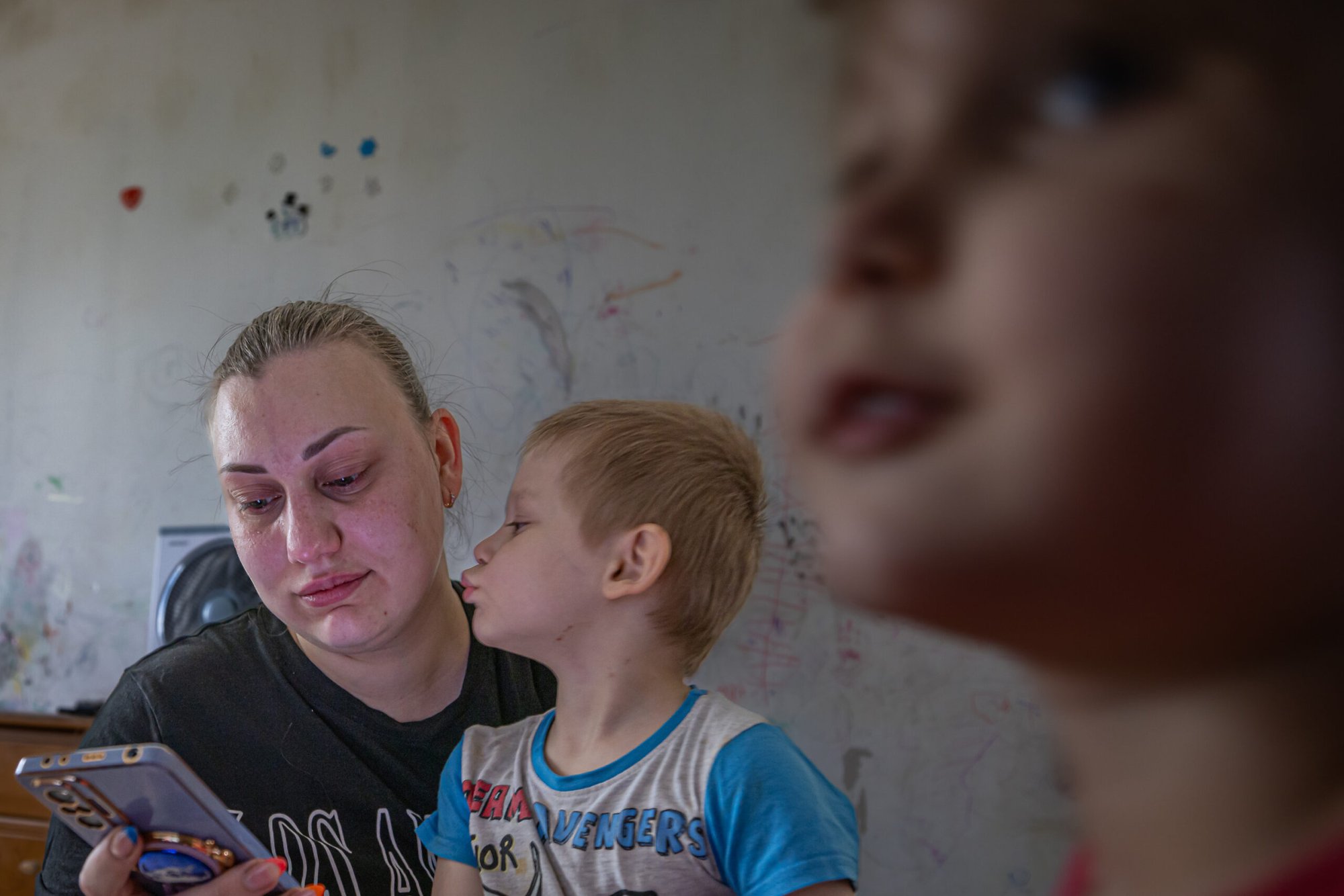
© Michael Nigro
Poland, Siedlce, June 15, 2023
Eugenia Mazur, a Ukrainian mother of five, struggles daily to manage her energy for the various needs of her family. Embracing her family’s new life in Poland, mending the children’s psychological scars from months of Russian bombardments, and diligently monitoring those she left behind, particularly her parents, in Hirnyk, Ukraine, the village she fled, mere kilometres from the frontline. Eugenia is piecing their lives back together, although she confesses that none of the children are the same. Her lifeline to her parents is her phone. (Photo taken while on assignment for Truthdig.)
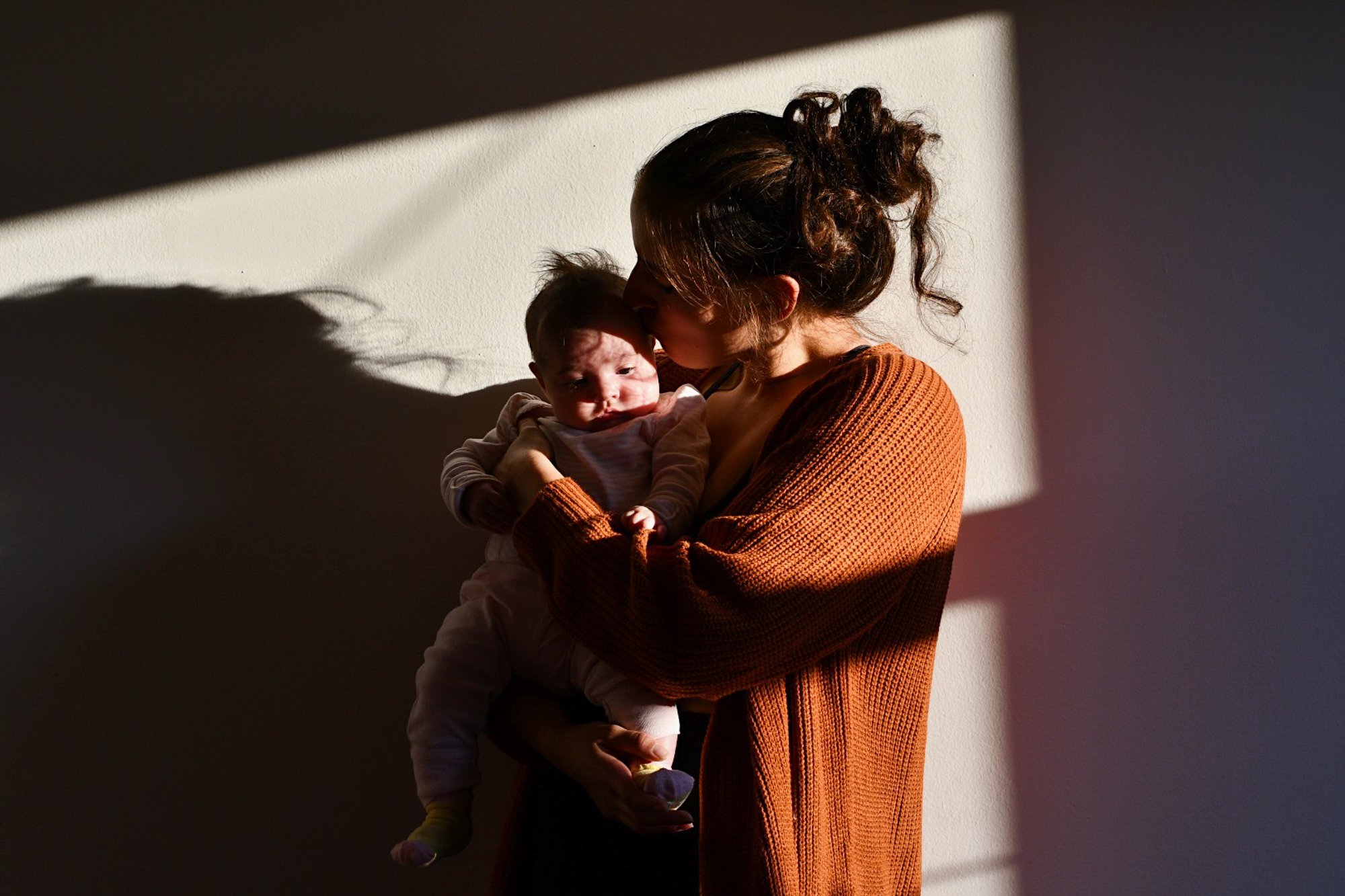
© Sheridan Smith
United States, New York, November 18, 2022.
Magi Figueroa, 27, kisses her daughter in their Brooklyn apartment. That year, Magi confronted the baby formula shortage, the COVID-19 pandemic, and the rising cost of living in New York City as a new mother. Named after her great-grandmother, Ava Jayne Figueroa was born on August 15, 2022. After a 15-hour labor and a failed epidural, Magi said she would remember her nurses, Marissa and Jessica, for the rest of her life. “It was by far the hardest thing I have ever done,” Magi said, “but honestly, now I am in total awe of myself. I feel like I am capable of anything.”
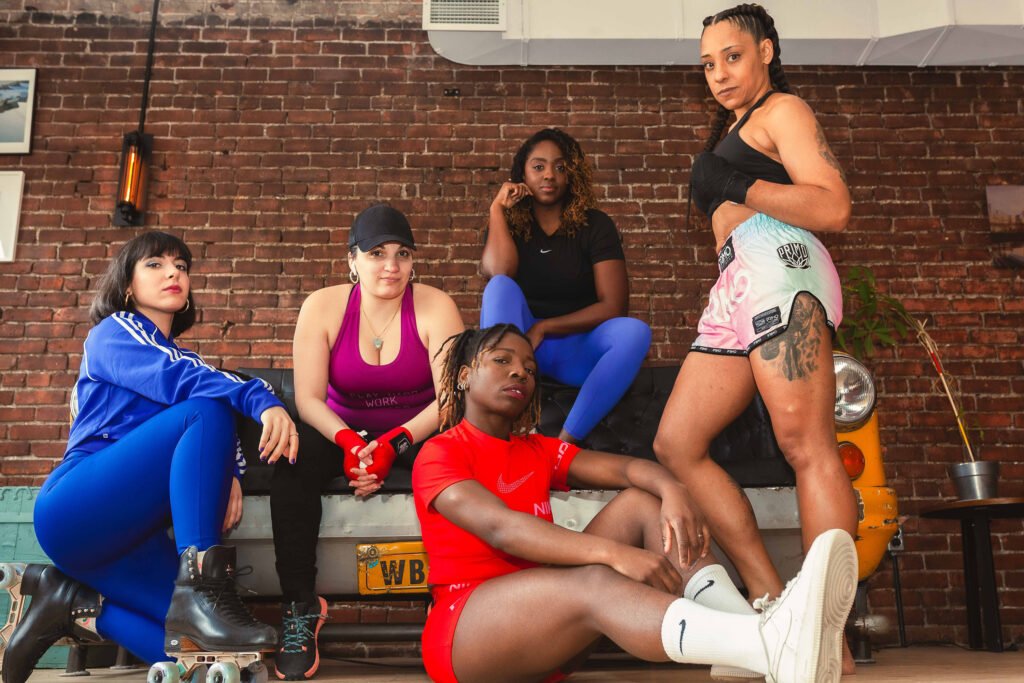
© Karene-Isabelle Jean-Baptiste
Canada, Montreal, February 25, 2024.
Embracing strength, power, and beauty through exercise, women redefine fitness and femininity. Captured during the annual thematic photo event Unique et Plurielles.
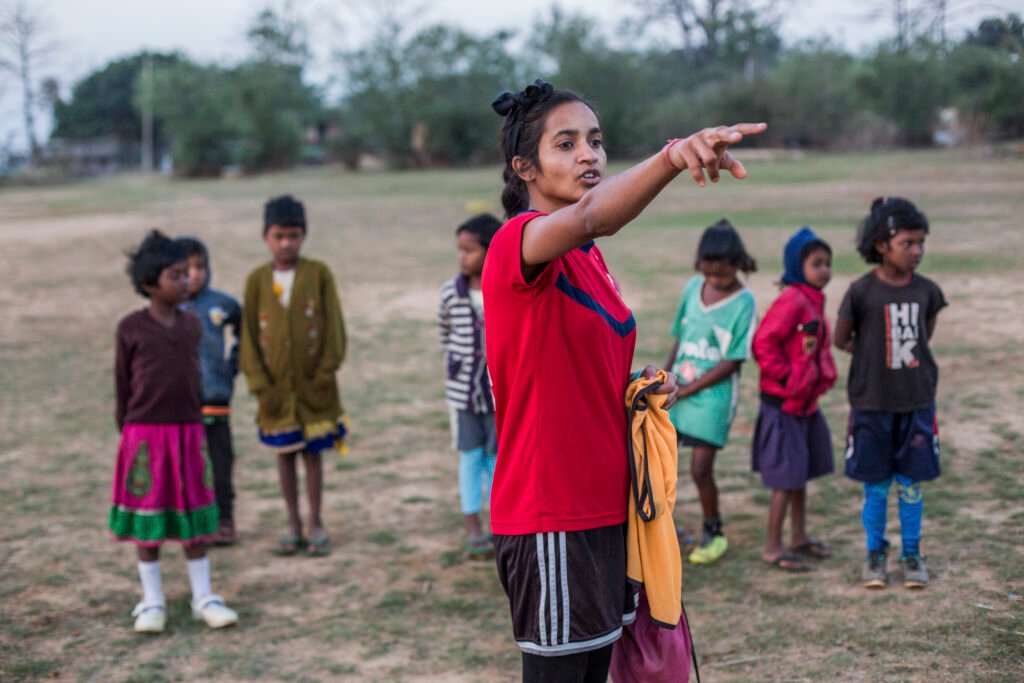
© Virgnie Nguyen Hoang
India, Jharkhand, March 22, 2019
Rinky: “Football as a tool of empowerment”
Jharkhand, India, is one of the poorest Indian states and also one of the most affected by teenage marriages, pregnancies, and child trafficking.
In the early morning, several young girls from this state train at football. “Here, what parents
want is that they get married, settle down with their husband, and have children”, explains
their coach, Rinky. The training she gives goes beyond simple techniques and
advice. “I want them to know that they can become independent women and realize their
dreams if they want it.” By coaching them almost every morning, the teenager gains the
money needed to finance her studies, which her parents had neither the means nor the desire to offer to her.
Text by Sabine Verhest. From the project “What the foot?!” by the Collectif HUMA.
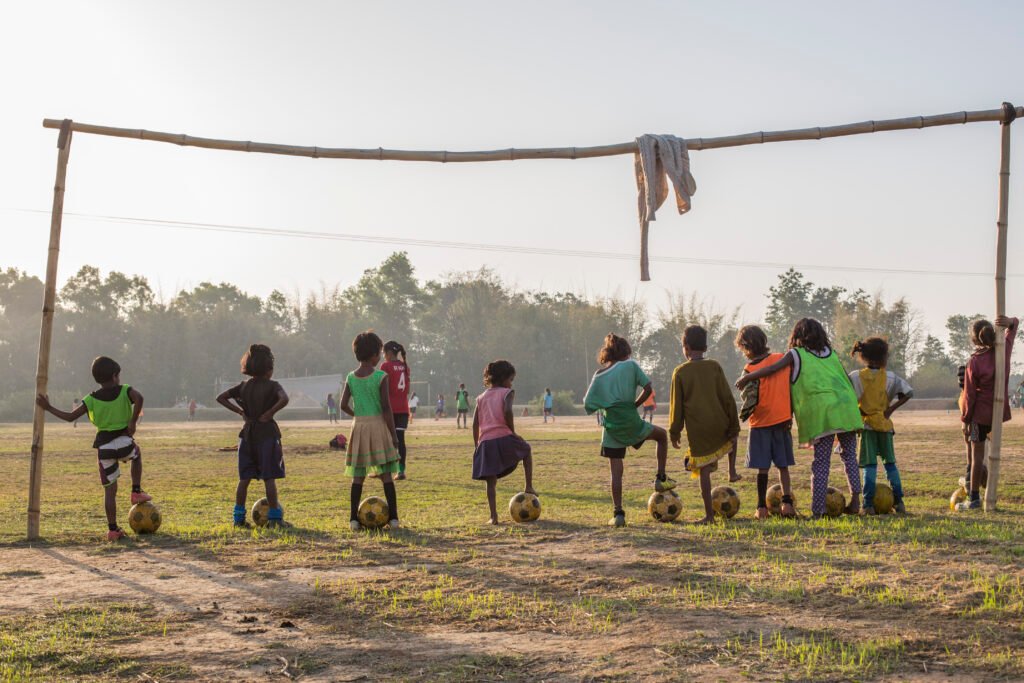
© Virgnie Nguyen Hoang
India, Jharkhand, March 22, 2019
Rinky: “Football as a tool of empowerment”
Jharkhand, India, is one of the poorest Indian states and also one of the most affected by teenage marriages, pregnancies, and child trafficking.
In the early morning, several young girls from this state train at football. “Here, what parents
want is that they get married, settle down with their husband, and have children”, explains
their coach, Rinky. The training she gives goes beyond simple techniques and
advice. “I want them to know that they can become independent women and realize their
dreams if they want it.” By coaching them almost every morning, the teenager gains the
money needed to finance her studies, which her parents had neither the means nor the desire to offer to her.
Text by Sabine Verhest. From the project “What the foot?!” by the Collectif HUMA.
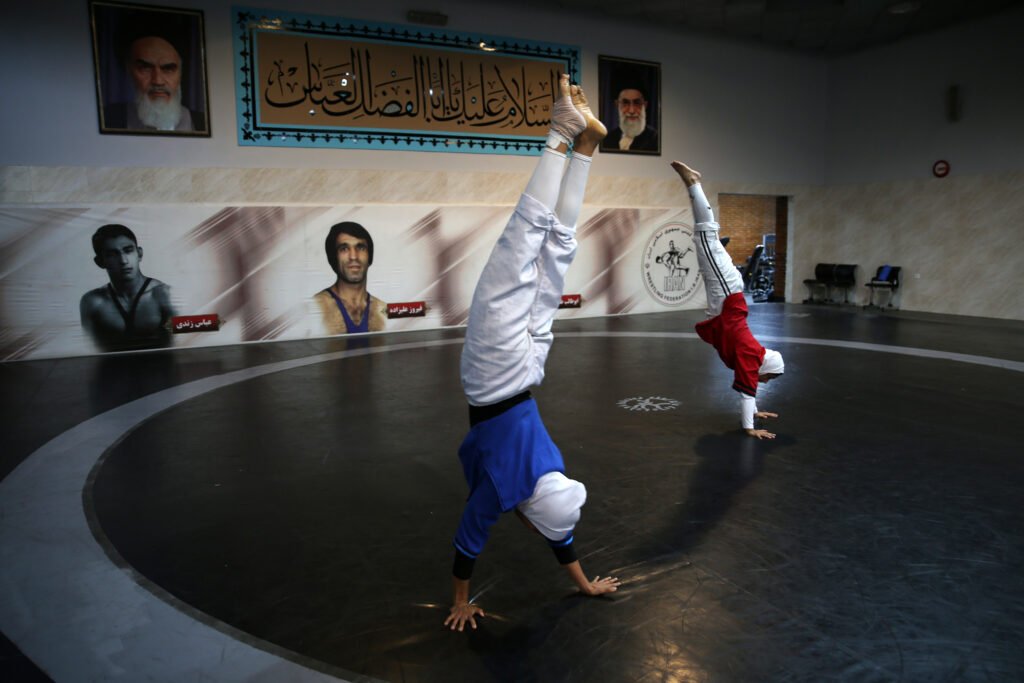
© Maryam Majd
Iran, Tehran, August 23, 2022
Iranian female national belt wrestler during the training session in Wrestling House in Tehran before going to the World Championship 2022 in Turkey.
“Women wrestling? Such a thing is not possible.”
In Iran, where traditional gender roles have long prevailed, the emergence of women’s wrestling is a groundbreaking development. Wrestling, a deeply rooted male-dominated sport in the country, has gradually opened its doors to women who are now challenging stereotypes and making history. Despite initial resistance, women wrestlers gained official recognition, earning respect for their skill and dedication. While challenges persist, these women have paved the way for future generations, proving that determination and passion can break down even the most entrenched barriers, reshaping the landscape of wrestling in Iran. It should be noted that obtaining permission to photograph women’s wrestling is one of the most challenging permissions due to its sensitivity in showcasing women’s sports, and the Iranian Wrestling Federation imposes serious media restrictions.
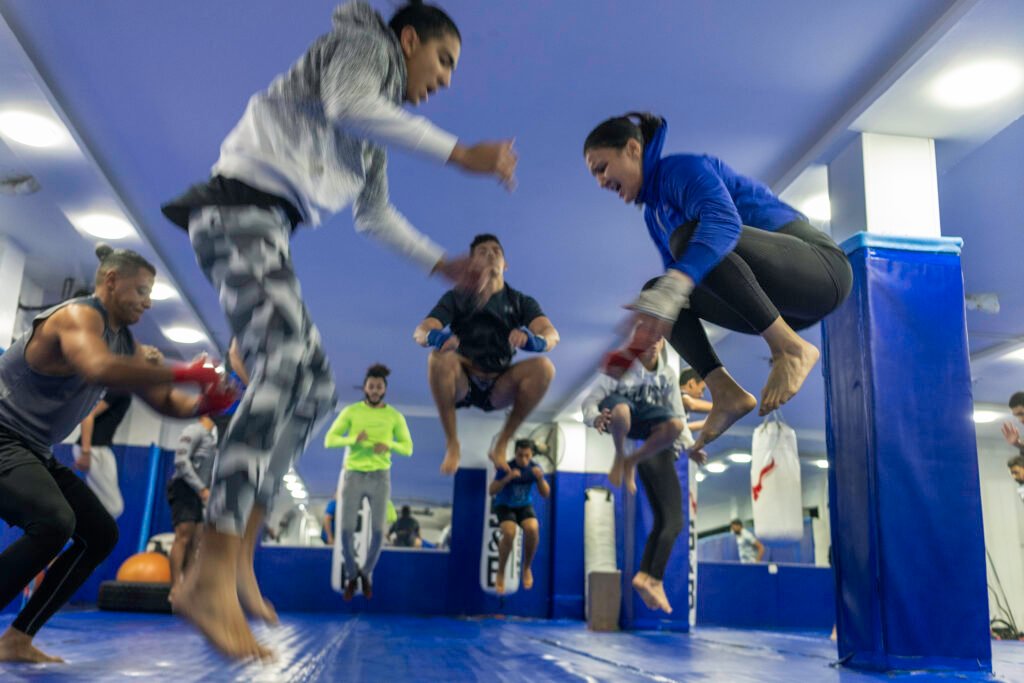
© Mohamed Hozyen
Egypt, Cairo, December 26, 2021.
Dina, fearless and determined, hones her MMA skills alongside the boys at S&B Academy in the vibrant heart of Cairo.
Driven by the need to protect herself and her sisters, she embraces the rigors of training, finding empowerment in every punch and kick.
In a world where few can match her skill and determination, Dina thrives in the company of both her male and female counterparts. They push her limits, elevate her prowess, and together, they forge a path towards her ultimate dream: to become a renowned fighter on the global stage.
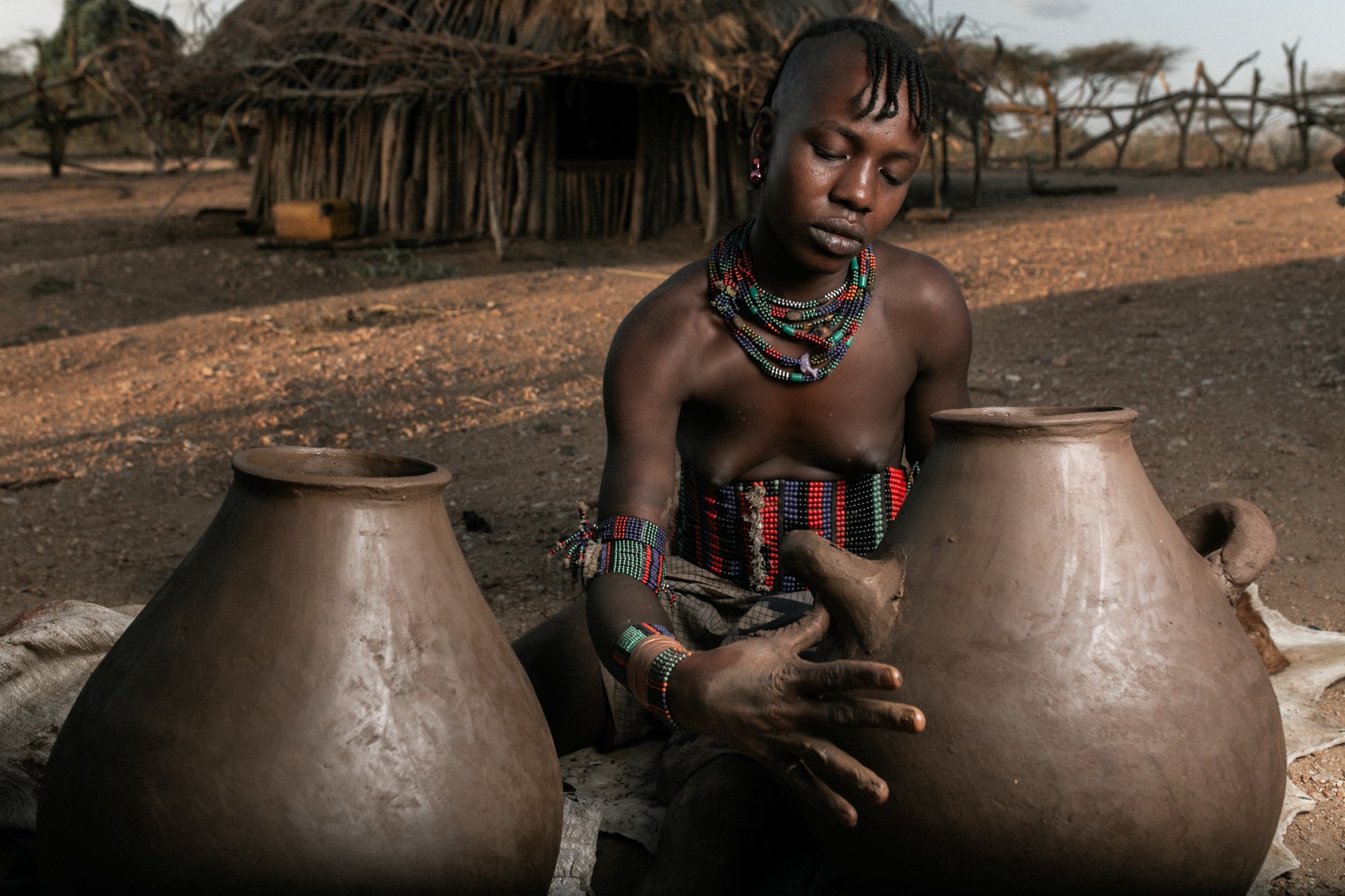
© Ezekiel Angeloni
Ethiopia, Omo Valley, February 2, 2017.
A young woman engages in the ancestral task of crafting clay pots. This art, passed down through generations, is essential for her community’s daily life; not only for its utilitarian value but also as a rich and vibrant cultural expression. In these ancient tribes, the role of women transcends the everyday: they are keepers of tradition and fundamental pillars of the social fabric. Through their hands, clay comes to life, transforming into vessels that tell stories of resilience, community, and the intrinsic connection to the earth.
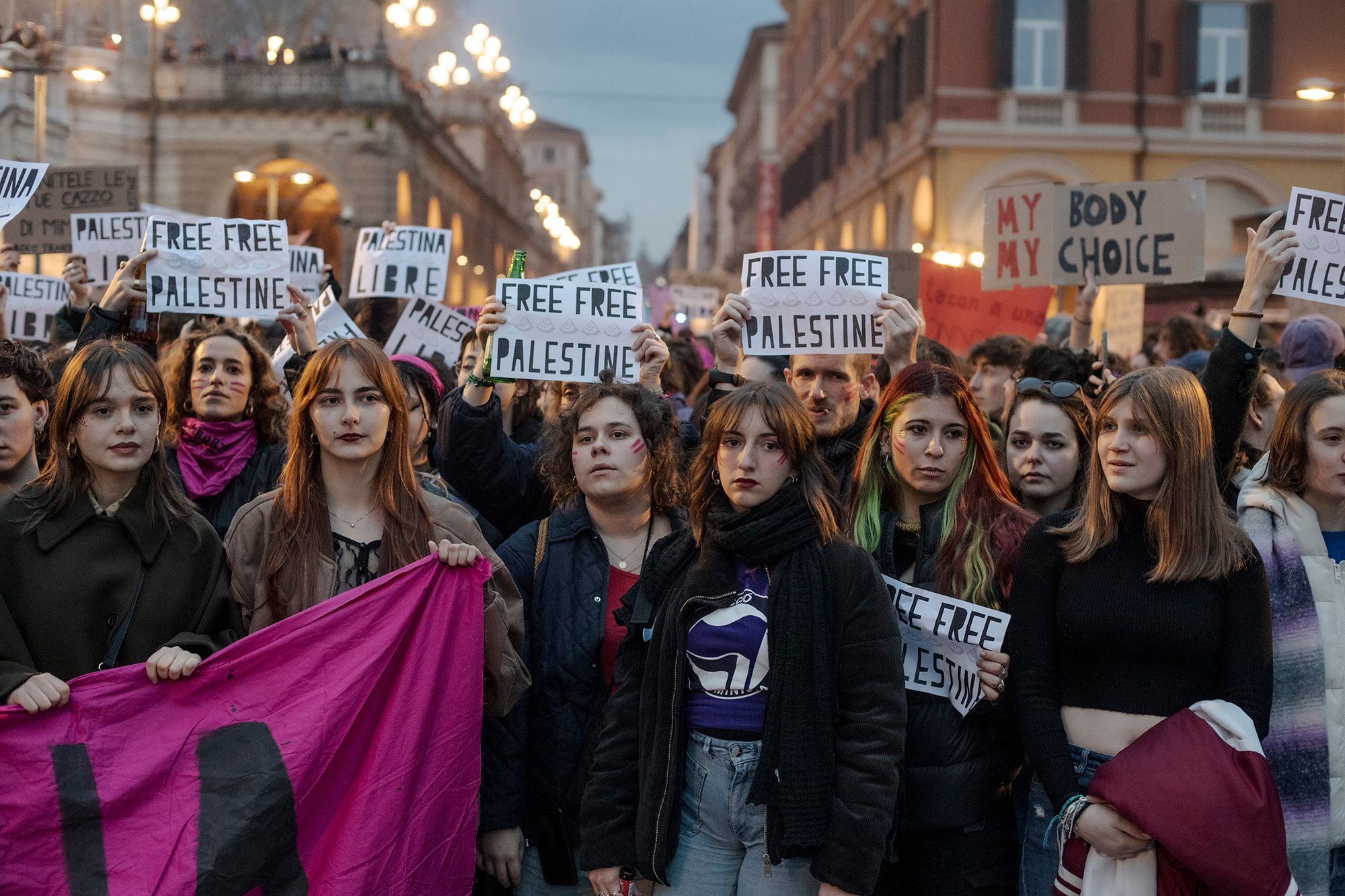
© Michele Lapini
Italy, Bologna, March 8, 2024.
“No feminist struggle without Gaza.
There is no future without Gaza.”
Thousands marched in Bologna in the rain for the transfeminist strike against patriarchal violence promoted by Non-Una Di Meno on 8 March, International Women’s Day. A demonstration marked by the transfeminist movement’s solidarity with Palestinian women, denouncing Israel’s genocide and colonial violence in Palestine.
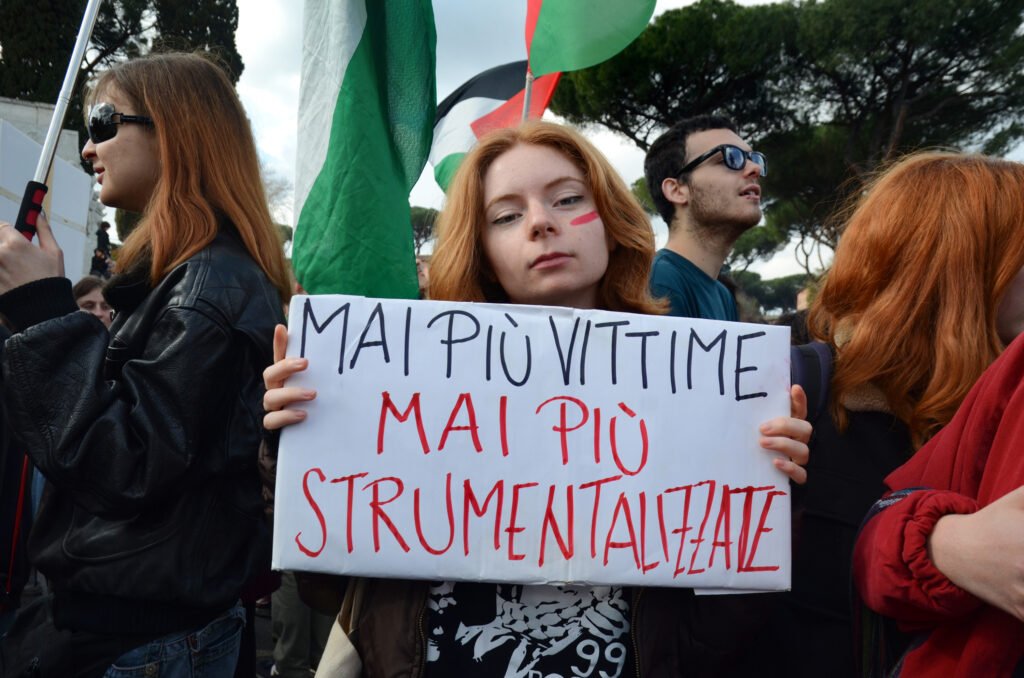
© Greta Argentieri
Itay, Rome, March 8, 2024.
At the protest held for International Women’s Day, a young woman holds a sign with a powerful message: “Never Again Victims, Never Again Exploited”
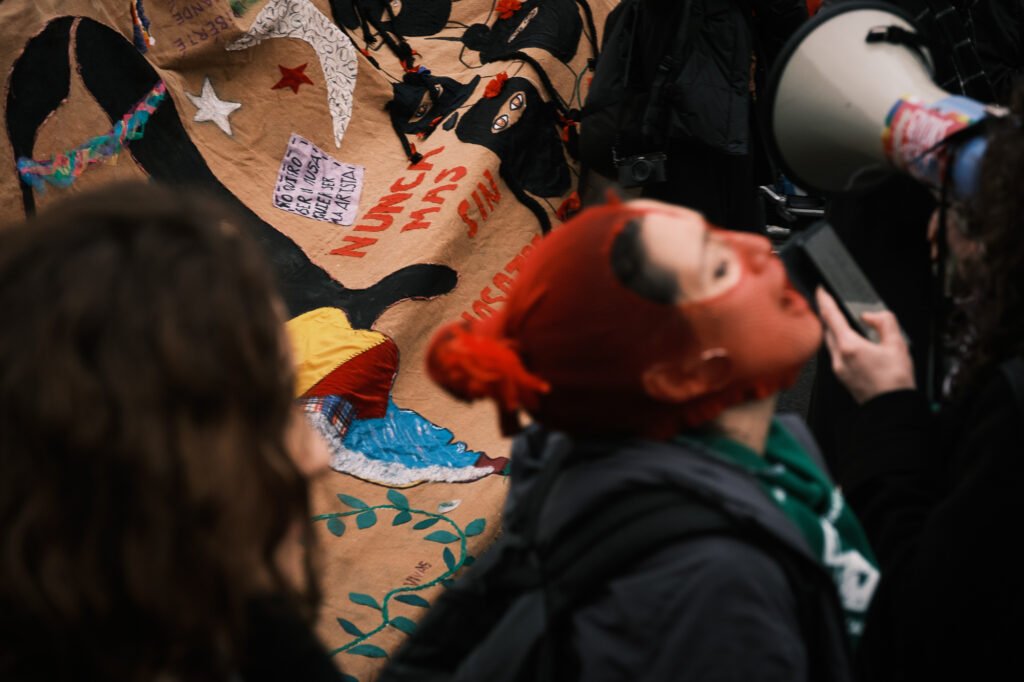
© Bastien André
France, Paris, March 8, 2023.
In the midst of ongoing pension reform protests drawing large crowds to the streets, a group assembled behind an embroidered banner honoring Houria and Cassandre. These two students were raped and killed in 2011 in Argentina, and after the first trial verdict, some questions concerning their death are still left unanswered. The demonstration, held on International Women’s Day, stirred intense emotions, ranging from anger to mourning, all driven by a singular cause: equality.
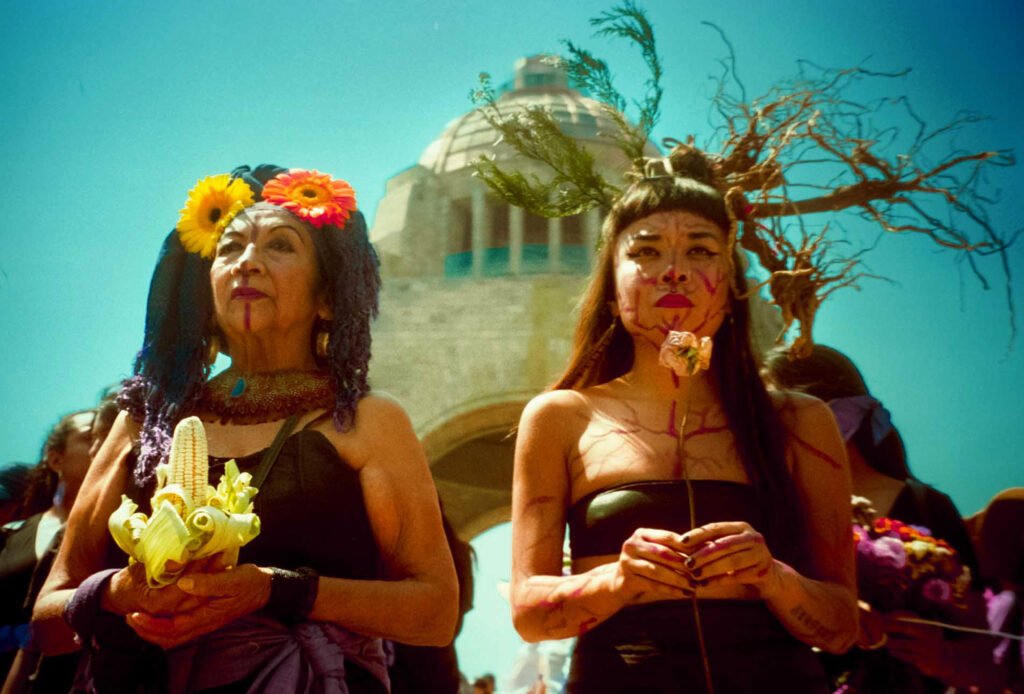
© Ludovica Anzaldi
Mexico, Mexico City, March 8, 2020.
Portrait of two women standing proudly at a parade cordon, symbolizing different ethnicities.
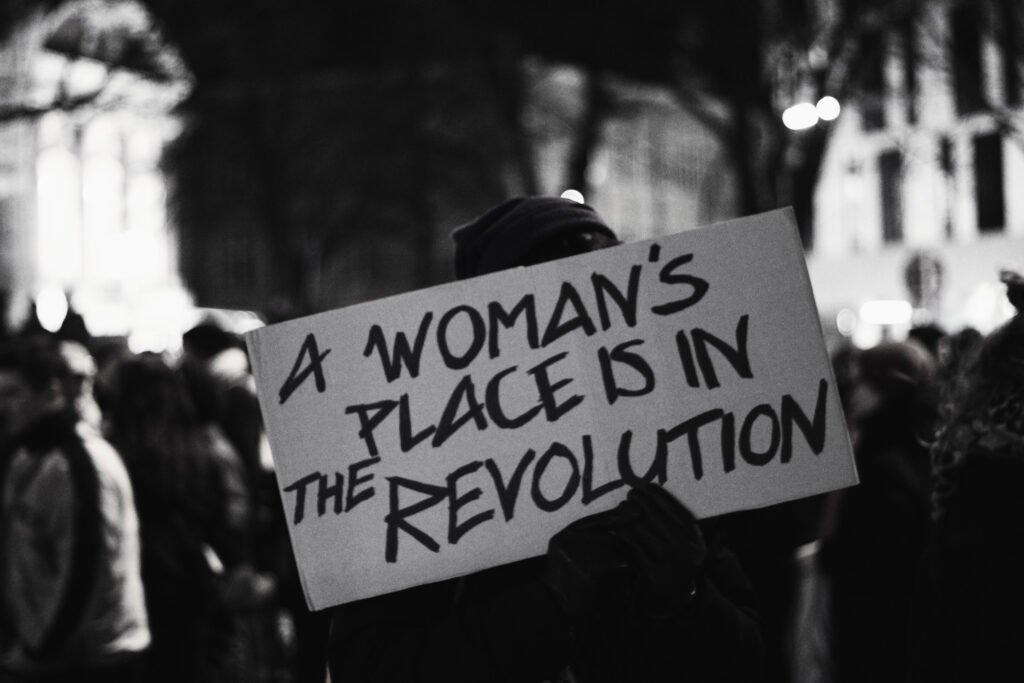
© Esther Zaim
Germany, Hamburg, March 8, 2024
A powerful message resonates as a demonstrator proudly holds up a banner proclaiming “A Woman’s Place is in the Revolution” during the March 8 demonstration.
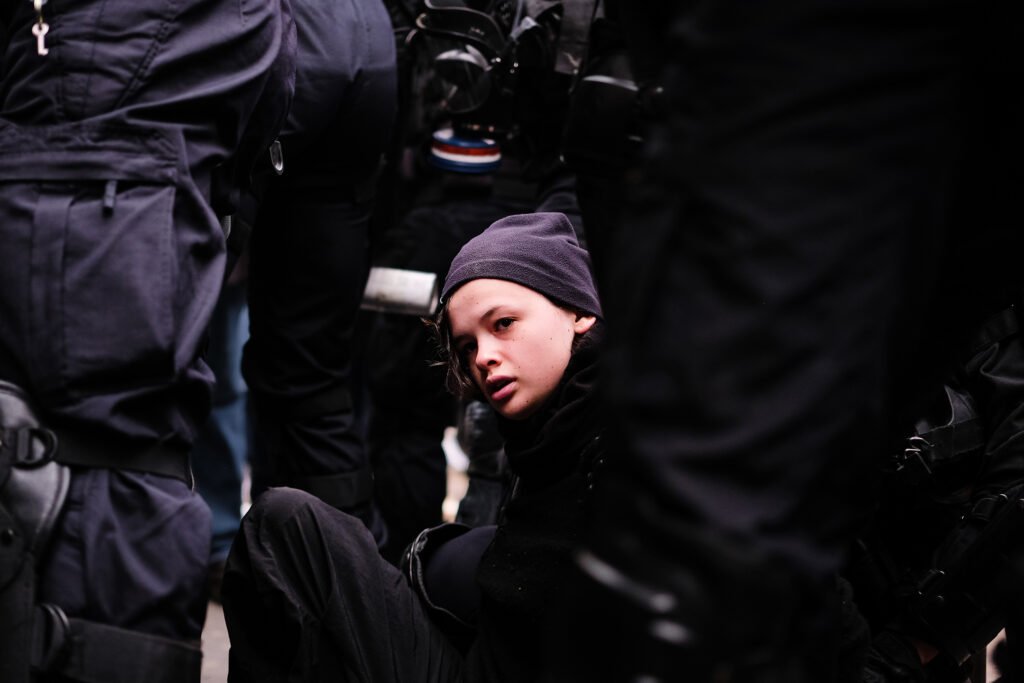
© Vincent Koebel
France, Paris, March 28, 2023.
A protester being arrested by police during a demonstration against pension reform in France, capturing the tense atmosphere as citizens voice their opposition to proposed changes.
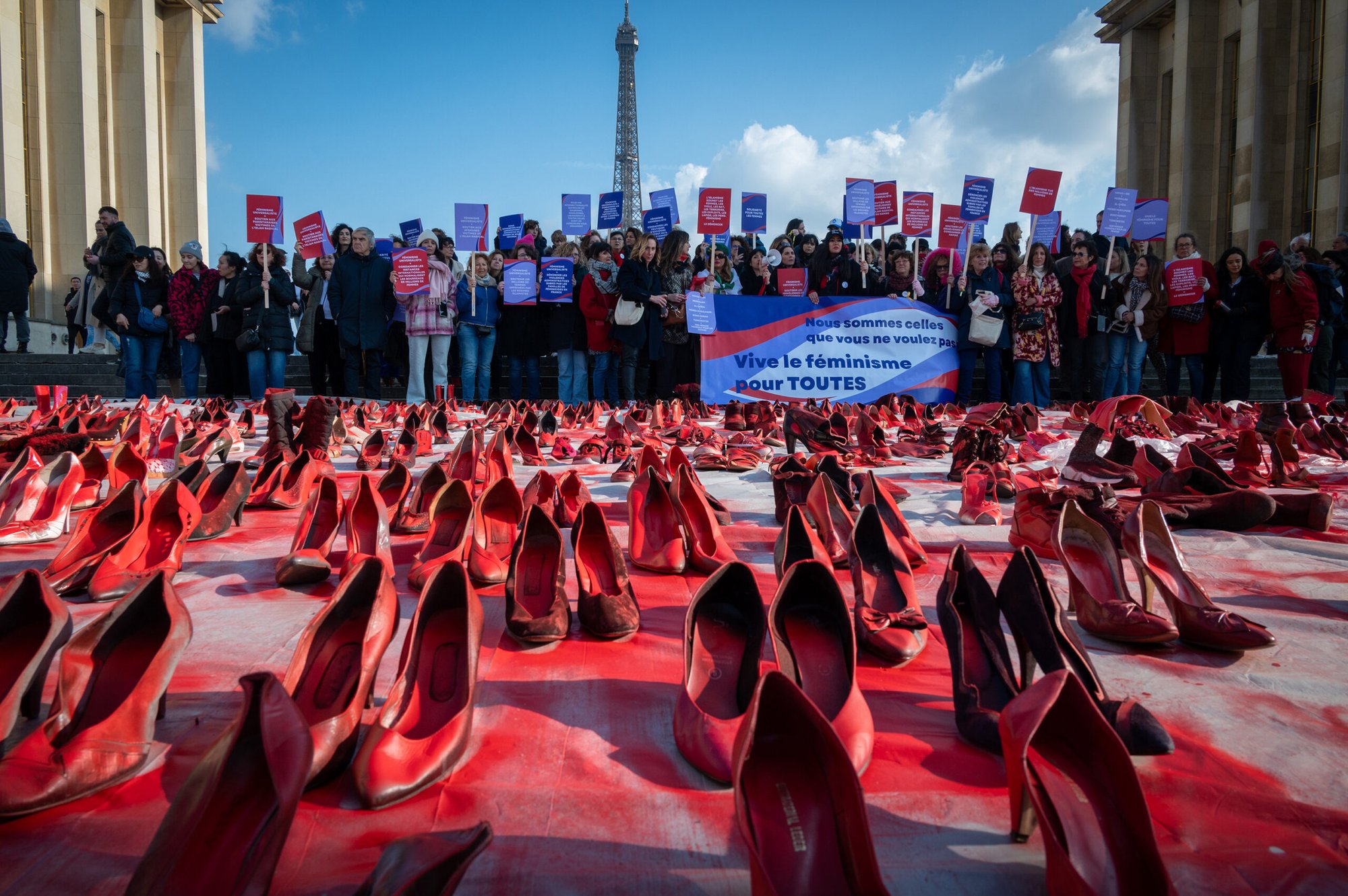
© Kelly Linsale
France, Paris, March 7, 2024.
One day before International Women’s Day, an action was taken in Paris, to denounce femicides. Each shoe laid down represented a woman who tragically lost her life under the hands of a man.
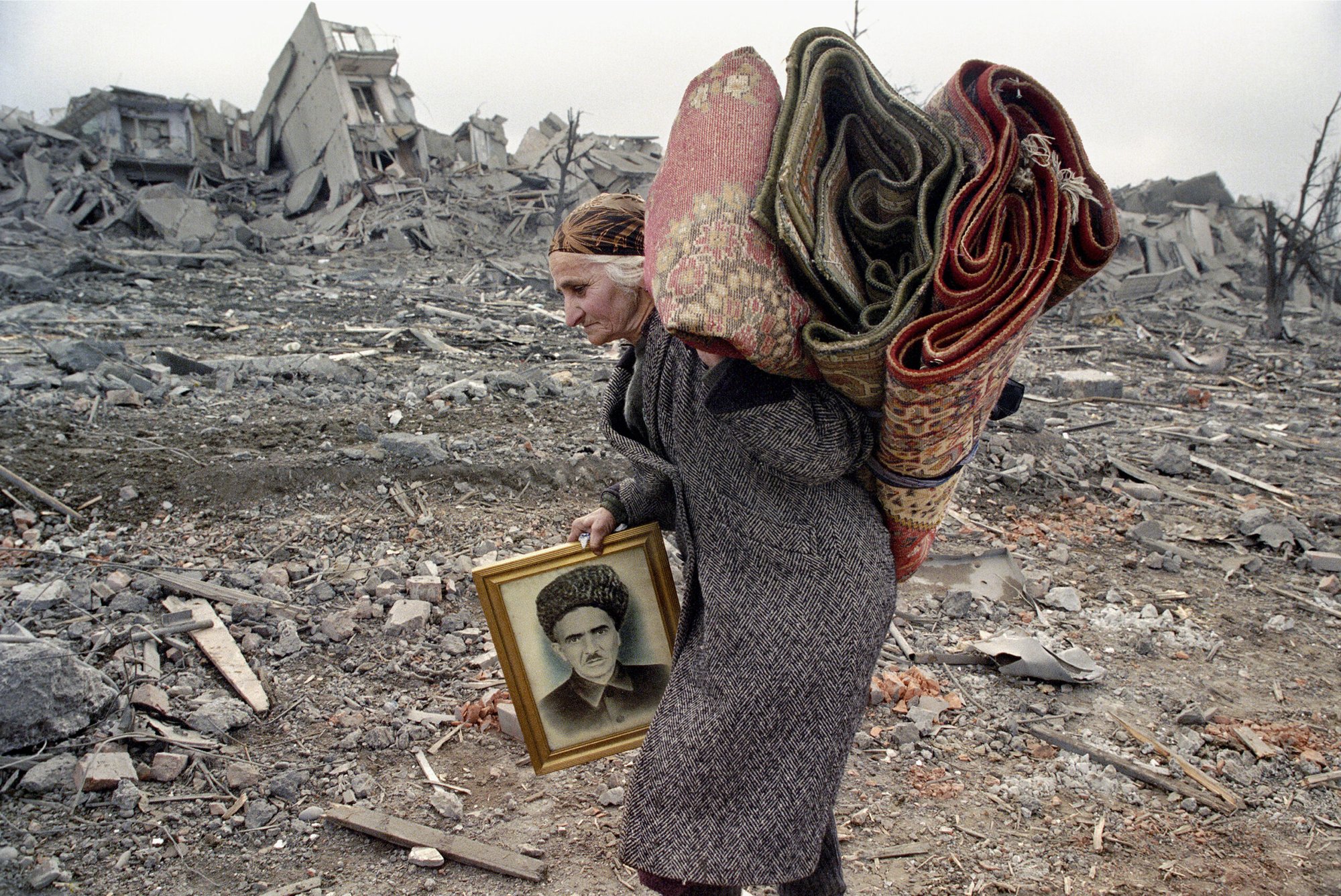
© Eric Bouvet
Russia, Chechnya, February 2000.
In the aftermath of the destruction caused by the Russian army, she walks alone through the ruins. Buildings were demolished to prevent Chechen fighters from returning to hide there. With her husband and two sons lost to the conflict, she was compelled to flee her home, carrying only a photo of her husband and two carpets.
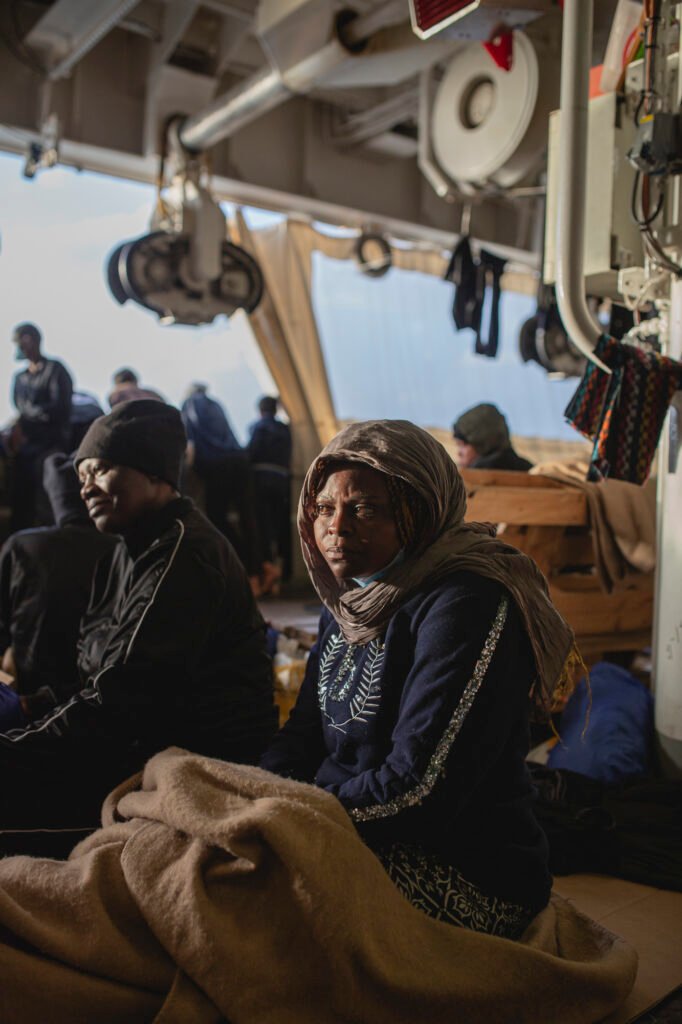
© Mahka Eslami
Italy, Naples, December 11, 2022.
On the Geo Barents, the Doctors Without Borders/Médecins Sans Frontières (MSF) rescue ship in the central Mediterranean, Decrichelle, a 32-year-old Cameroonian mother of two, wakes up on the morning of the landing day, awaiting disembarkation in Salerno, Italy.
Through Nigeria, she fled a forced marriage to a violent man. When Decrichelle arrived in the desert, her daughter fell ill, and she could not do anything to treat her because she had no access to care or medicine. She lost her daughter and had to leave her there, before continuing with the group towards Algeria. She tried to cross the sea once but was arrested and sent to prison, where she was released immediately, only to be put into a cab and sent to a place of prostitution. A couple of Cameroonian friends helped her get out. She lived for six months in the Campos, the abandoned buildings or large outdoor spaces near the sea where traffickers corral migrants, before raising the money for another crossing. “I want to be in a place where I can live my age because I don’t live my age. Too much suffering, too much stress. I want to be able to sleep at night,” she says.
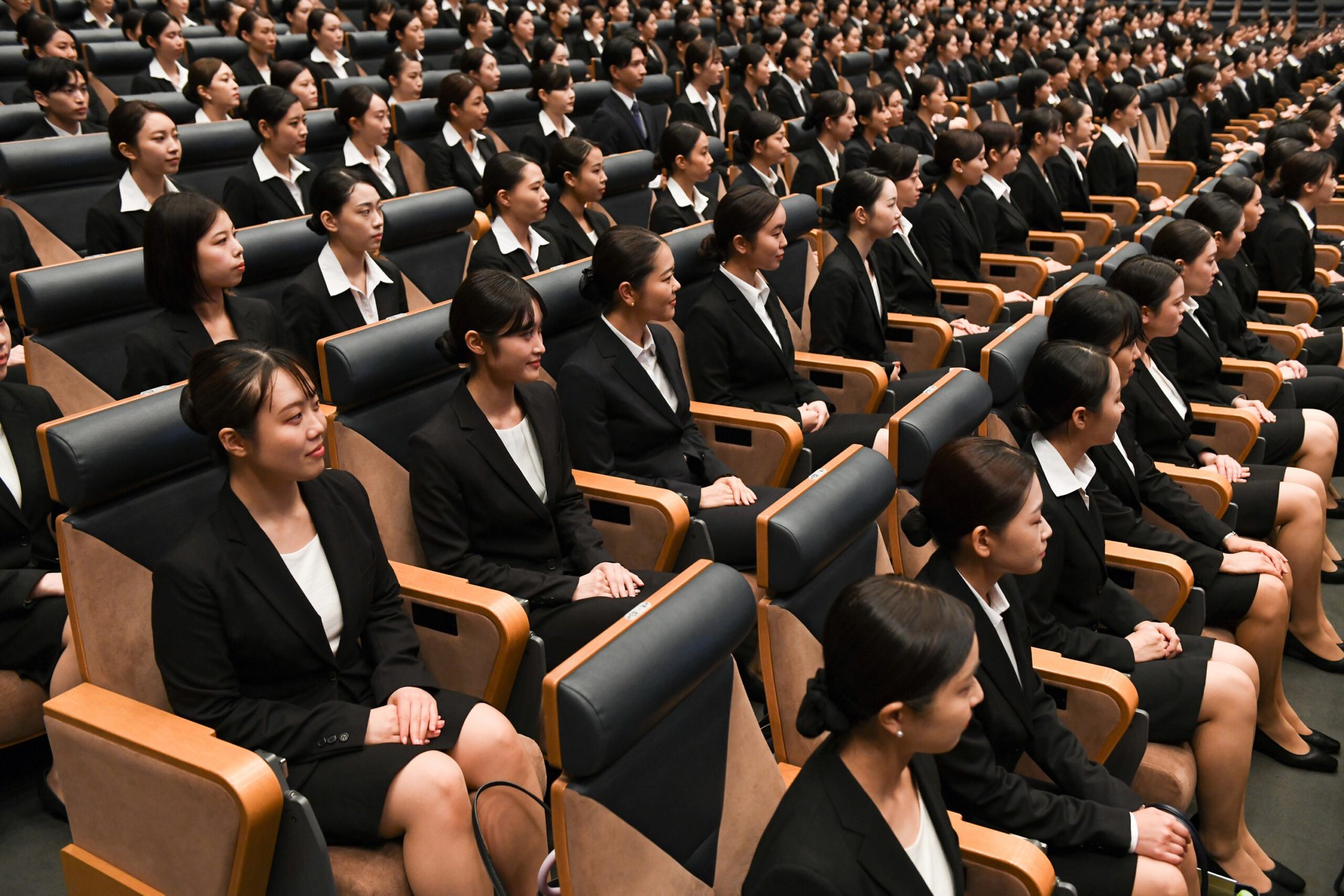
© Noriko Hayashi
Japan, Tokyo, October 1, 2023.
Newly hired flight attendants of All Nippon Airways (ANA) gather for their induction ceremony in Tokyo.
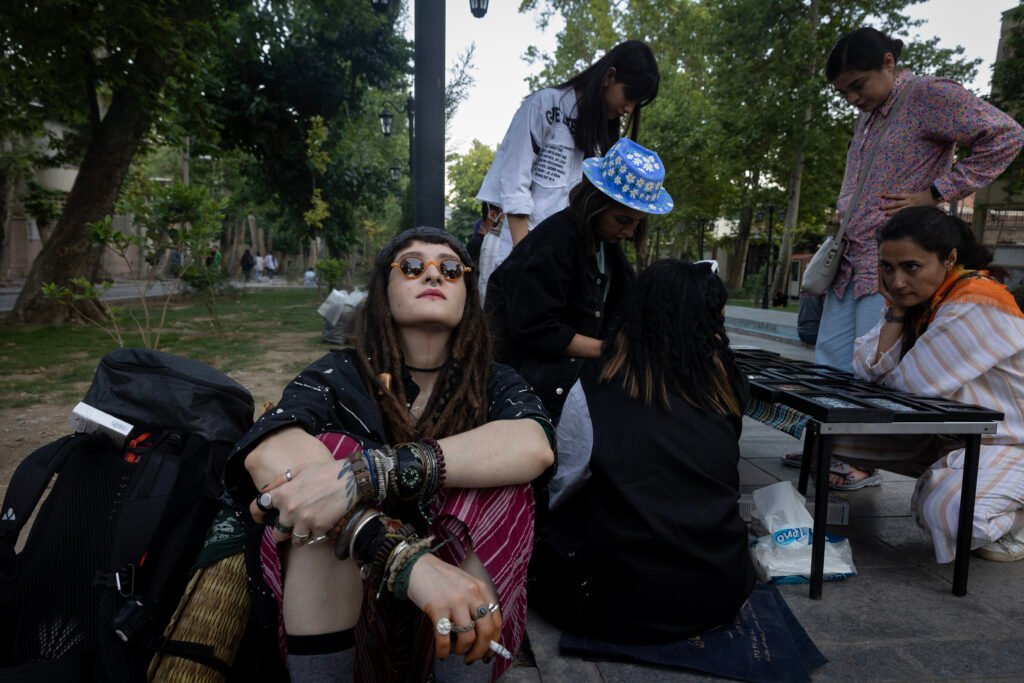
© Maryam Rahmanian
Iran, Tehran, March 23, 2023.
An Iranian girl dresses freely like a hippie as she smokes in the northern part of Tehran.
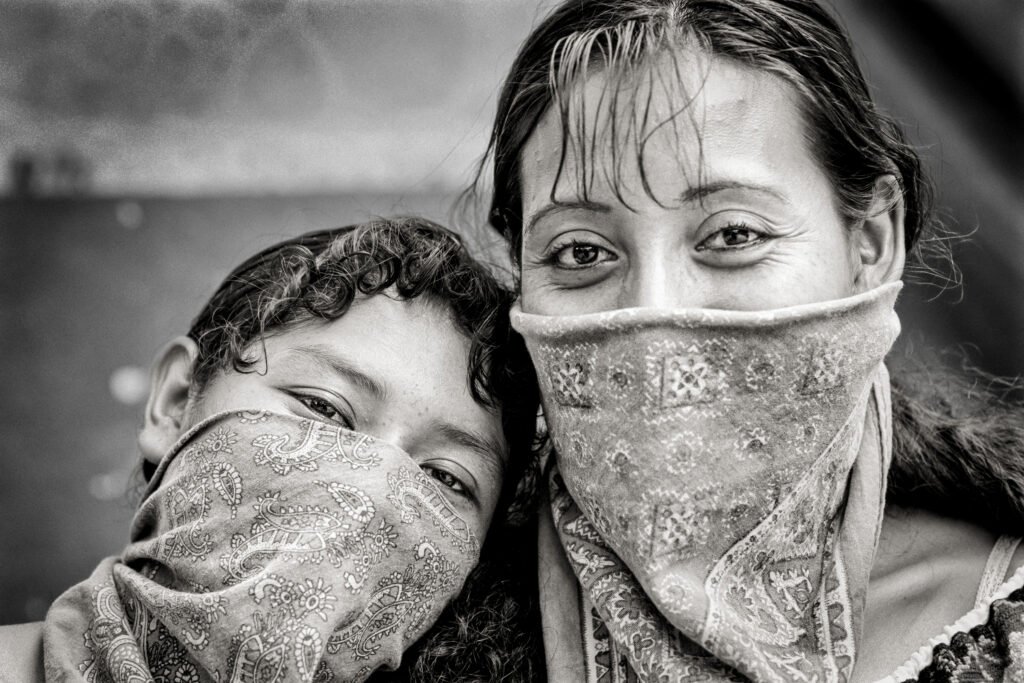
© Massimo Tennenini
Mexico, Chiapas, October 2005.
Portrait of Zapatista women in the Lacandon Jungle.
The Zapatista movement, born in the Chiapas region located in southeastern Mexico, has placed particular emphasis on promoting women’s rights, including access to education, healthcare, justice, and political participation. Zapatista women have fought against gender discrimination and for equal opportunities within the movement and in their communities. Women have contributed to building a form of government based on participatory democracy and self-governance in Zapatista communities. They have made political decisions and played an active role in the decision-making processes within their communities.
Overall, the role of women in the Zapatista uprising has been crucial for the movement as a whole. Their participation has contributed to the creation of an inclusive and diversified movement that has fought for indigenous rights, social justice, and political autonomy in Chiapas and throughout the country.
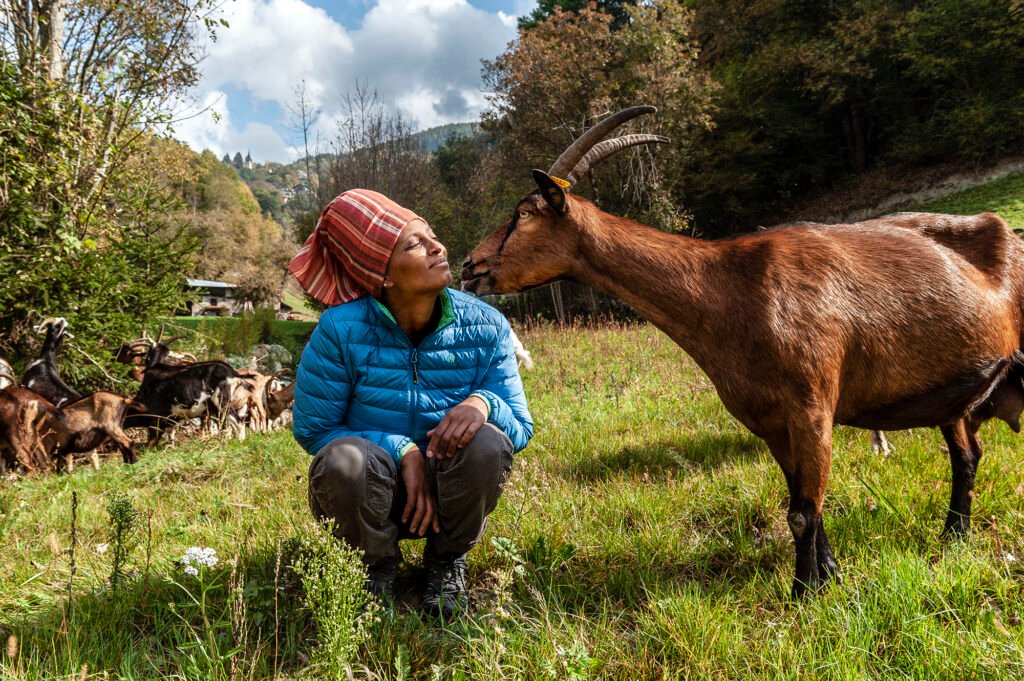
© Isabella Balena
Italy, Trentino, Mocheni Valley, October 15, 2018.
AGITU IDEO GUDETA: Originally from Addis Ababa, she earned a scholarship in sociology at the University of Trento, Italy, when she was just 18. After returning to Ethiopia in 2010, she had to flee her country to escape arrest due to her activism against land grabbing. Finding refuge in Italy, specifically in Trentino’s Mocheni valley, she embarked on a fresh start. Reclaiming abandoned land, she revived local goat breeds facing extinction. Thus, she established “La Capra Felice,” an agricultural venture specializing in organic goat farming, offering organic cheeses, and goat milk cosmetics. Tragically, Agitu was murdered by one of her employees in December 2020.
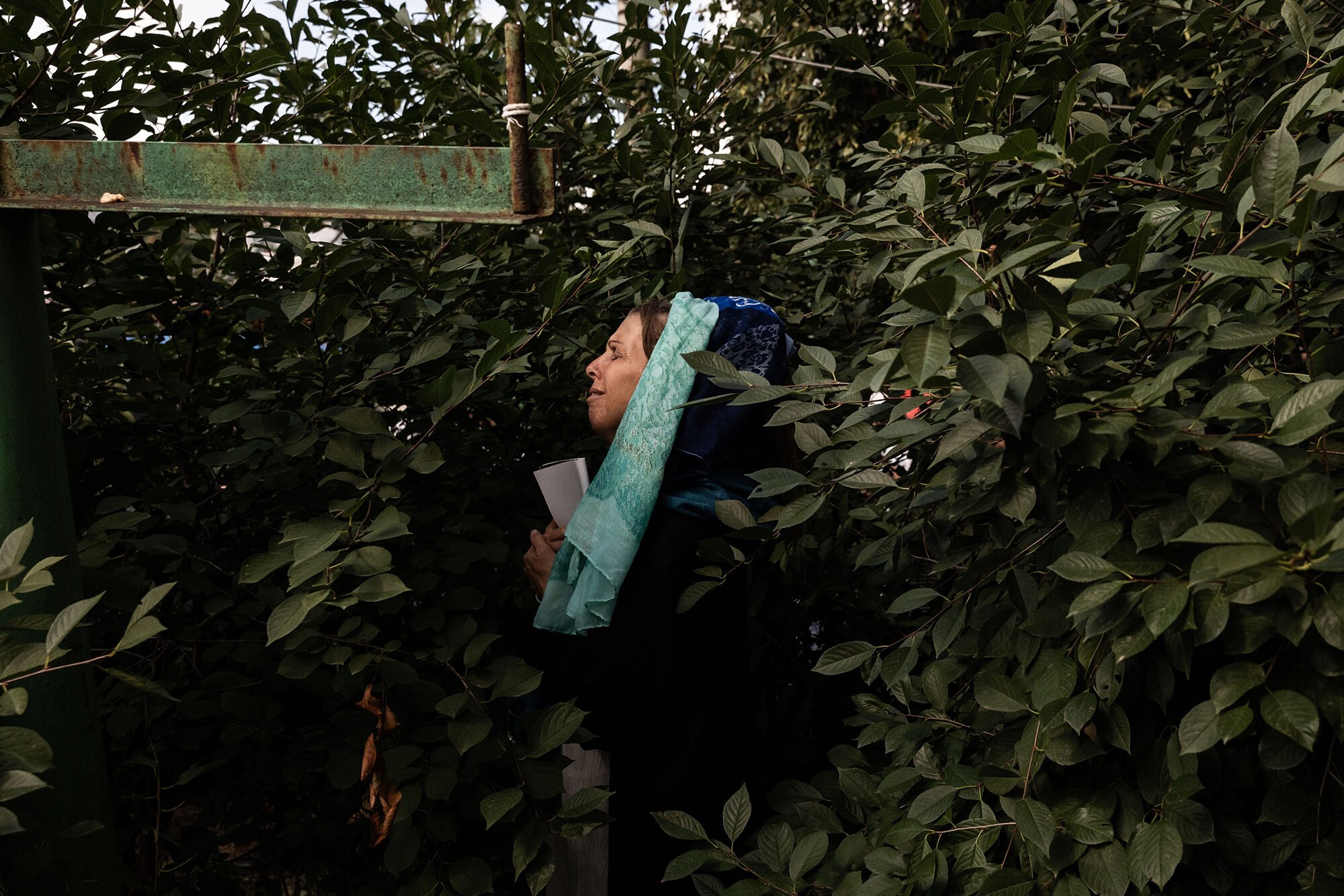
© Svet Jacqueline
Ukraine, Uman, September 15, 2023.
Rivka prays in the bushes, the only bit of shade in a Section of a Hasidic Jewish pilgrimage site in Uman, Ukraine. On her first trip to Uman, her son was dying of a rare cancer. She says that this trip was their last together and remembers holding him and praying while enduring disapproving glares from male attendees.
Every year in Uman, a city 130 miles south of Kyiv, thousands of Hasidic Jews make the pilgrimage to the grave of Rabbi Nachman. The event, which falls in September, has historically been coveted as a “men’s only event.”
Women were pushed to the outskirts of the temple onto a small patch of grass divided by an iron fence that obstructed their views while they echoed the celebrations from within the temple walls. The division of gender is an interpretation that is rooted in tradition, but the struggle for equality in the community as a whole is an ongoing battle, and women visiting Uman face these challenges head-on when choosing to make this pilgrimage.
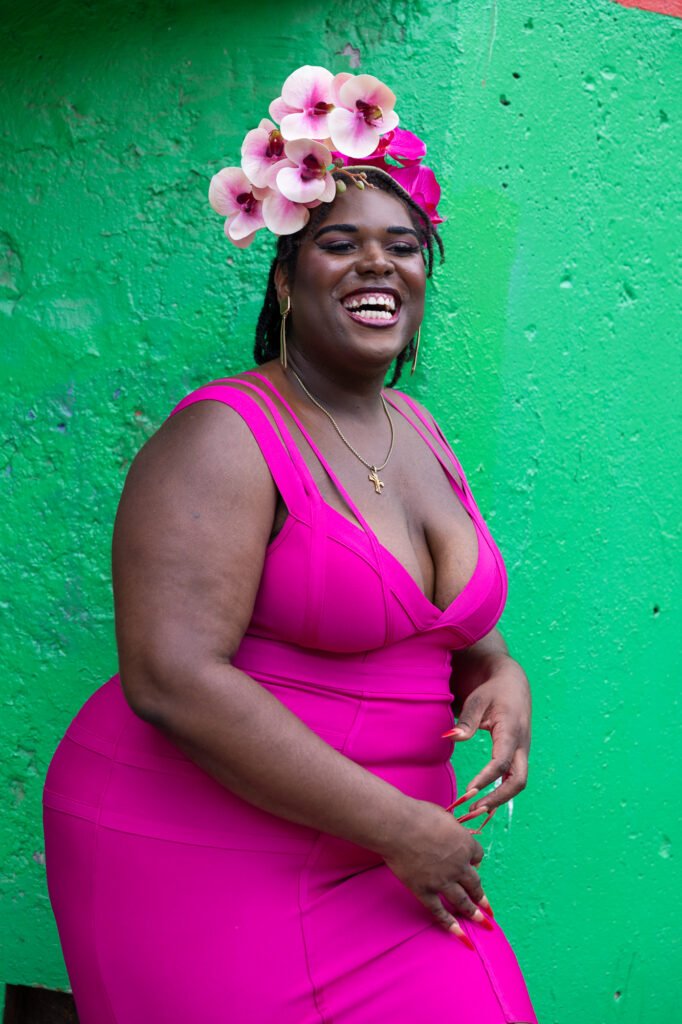
© Erica Lansner
United States, New York, August 30, 2023.
Portrait of Qween Jean, costume designer and founder of Black Trans Liberation, at the Trans Cookout.
I’ll end on a note of celebration, with Erica Lansner’s photo that seems to embody such vivacious joy: the colors, the smile, the flowers, the amazingly manicured fingernails! This is a portrait of Qween Jean, founder of Black Trans Liberation. It is a beautiful visualization of the fluidity of genders, the celebration of historically under-represented identities, and the appreciation for all the achievements made not only by women’s groups, but by all trans, non-binary and related efforts. Femme identities include LGBTQ+, and while International Women’s Day has come and gone, I hope that every day we can be more mindful of all women—cis, nonbinary, queer, trans, and beyond—in admiring their accomplishments and in recognizing that there is still so very much more change to be made for full acceptance and equality.1
Footnotes
- The data in this essay on gender inequality comes from: Bonfert, Anna Tabitha and Divyanshi Wadhwa, “International Women’s Day 2024: Five insightful charts on gender (in)equality around the world,” World Bank Blogs, March 8, 2024, https://blogs.worldbank.org/en/opendata/international-womens-day-2024-five-insightful-charts-gender-inequality-around-world. (Last accessed March 20, 2024). ↩︎

